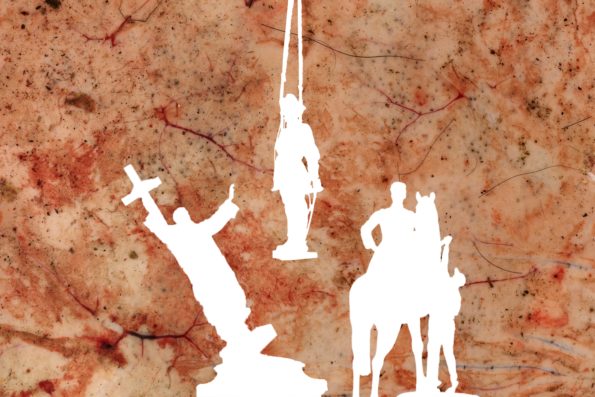Search
To search for an exact match, type the word or phrase you want in quotation marks.
A*DESK has been offering since 2002 contents about criticism and contemporary art. A*DESK has become consolidated thanks to all those who have believed in the project, all those who have followed us, debating, participating and collaborating. Many people have collaborated with A*DESK, and continue to do so. Their efforts, knowledge and belief in the project are what make it grow internationally. At A*DESK we have also generated work for over one hundred professionals in culture, from small collaborations with reviews and classes, to more prolonged and intense collaborations.
At A*DESK we believe in the need for free and universal access to culture and knowledge. We want to carry on being independent, remaining open to more ideas and opinions. If you believe in A*DESK, we need your backing to be able to continue. You can now participate in the project by supporting it. You can choose how much you want to contribute to the project.
You can decide how much you want to bring to the project.

I think often of the memory of bronze and flesh, the memory in our words, the memory in marble, the memory on paper and the memory on the screen. Memory that lives in the body and orality is constantly evolving and mutating [1] refer to what historian Pierre Nora describes as the milieux de mémoire, see Nora, Between Memory and History, memory written on paper transcends the lifespan of biological organisms, bronze and stone extends its lifetime for centuries in exchange for stability, and the screen returns to memory a capacity for its datafication and impermanence [2]Reading, ‘Seeing Red . Each medium conditions memory’s capacity for mutation or stability, for response or neglect, for healing or harm. But is not the bronze of the statues to Robert E. Lee, Cristopher Columbus, Edward Colston, or Fray Junipero Serra which offends and drives a global movement for their toppling. It is this capacity monuments have for affective programming–or mnemonic control as defined by cultural theorist Luciana Parisi–which we find culpable: the ransom of our cultural narratives by power structures which enforce permanence and maintenance of such objects in public space [3] Parisi and Goodman, ‘Mnemonic Control’. There we find the ill-spring of whiteness that imposes upon our social, environmental, and individual bodies–alive and present here and now–structures of hierarchy which dehumanise and oppress melanin-difference. Yet we fix our attention on those statues as proxies of past wars to preserve Black slavery, past colonial expeditions to extract wealth from earth, or past cultural genocide perpetrated upon First Peoples. We attach with excess of energy onto these representations of such pasts. But the past is never past [4] Faulkner, Requiem for a Nun, p 85. The violence of colonial and racist whiteness continues to be perpetrated upon the multiple and mutable presents of our diverse and divergent selves, not quite through the iron of chains, but mediated through the bronze of monuments which obfuscate violence yet to come. Freud wrote about how some of his patients, when asked to recall distant memories from childhood–too distant to be recalled accurately–as screened memories. Bronze so becomes a screen memory: an incomplete reconstruction of our own narrative, one which instigates the compulsive repetition of the violence of the past. [5] Freud, “Remembering, Repeating and Working-Through.” .
Such fixation upon the material of monuments in lieu of the materials of flesh and law often complicate paths to the working-through of trauma–it’s healing–which traverse processes of justice, reparation and non-repetition. For we don’t really remember just for the sake of remembrance. What we seek through remembrance is to understand our violent selves, and from there, take steps to redress our-selves, and so the locus of therapy becomes the bodies of our social, collective, gregarious, nature-bound others. That is what memory, in a most biological and fundamental dimension, is for: the ability to store acquired knowledge for later recall to intentionally avoid predictably disagreeable circumstances and plan for future action [6] Sherwood, 2010, 158. Yet the spaces of courts and institutions are too often too complex to work through with, and to transform their potential for violence into capacity for caring demands levels of agency and advocacy difficult to access–especially to those affected by barbarity. This is why I believe we have ritualized the destruction of the bronze in monuments: there we find no gatekeepers who defend with law the immutability of violent power structures. We come face to face, without apparent intermediary, to this metallic mediation of violence. When we overturn those statues of colonizers, an outlet for dignified rage is torn open through the fabric of public space. It also closes the wound too soon for it to heal. Without the sunlight and fresh air of public scrutiny and public truth, it festers in impunity until its soreness is a blight which no longer can be ignored, and we collect and commingle to tear bronze open again. Ritus ad perpetuam.
If it is liberation from violence that we have declared to seek, then the compulsive repetition of the ritual of toppling monuments which fixate the past presents two problems. First, we project the violence perpetrated by offending power structures and their agents onto the bronze–and if the dead don’t bother for the particulars of those alive, their representations care even less. Second, we displace the violence suffered by those alive today away from their bodies and communities, and focus efforts on to an abstract collective body of protest. What is problematic in these rituals aren’t the tensions between the individual and the collective, nor the loci of the past against the present, but the drive to choose one over the other because we continue to conceive time as linear and space as cartographic.
How can we find liberation from temporal linearity and spatial cartography, these narrative structures necessary for monuments to make sense? How could we stimulate temporal simultaneities and spatial topologies which collapse time and fold space so the colonizer of the past may converse with the colonized of today? Seeking possible answers, I turn to fiction–particularly science fiction–to imagine not just the futures where we face violence, but effectively transform it into justice, reparation, and non-repetition. Through this move, we may can gain focus on the narrational structures of the monuments we wish to topple today, as well as the narration of violence of tomorrow. The material then is not just bronze, or flesh, or law, but all these and more woven together through the fabric of fictional storytelling. To become capable of remembering the unmanifested. To anticipate–not just remember–memory.
I listen to the cries of Beloved in Toni Morrison’s rememory and the refusal of the past to be left past, but to collect present traumas which chase future generations to come. I mind-walk through novelist Juan Rulfo’s Comala, an entire town riddled with ghosts that whisper at night stories of violent pasts. [7] Ag, “Toni Morrison: Rememory and Writing” . Fiction abounds with narratives where irresolute pasts haunt characters whether they be accidental visitors or descendants. History, no longer concerned with positivist temporal linearity, has embraced an interest in spiraling conceptions of time as well. Historian Alexander Aviña’s view on cyclical histories of violence in Mexico, where irresolution and repetition of injustice possess new generations of social struggles, only to become spectres of revolution [8] Aviña, Specters of Revolution . Yet these examples engage the past with the present, but seldom look to the future to include this folding of time and space. Memory scholar Stef Craps engages productively with anticipated memory as he looks to how film and fiction has imagined futures where the climate crisis was not averted, and future historian’s perspectives narrate back to our present selves the catastrophe yet to come. [9] Craps, “Climate Change and the Art of Anticipatory Memory”.
And so I think back on bronze, flesh, paper and screen as the monuments fall. What will replace them? Will it be an updated sculpture that will be once again toppled in future ritual? Or can we challenge the material of memory radically, to collapse time and fold space into a new form of remembrance, of engagement with memory through fiction, to not just imagine the repetition of violence, but its continuous and impermanent liberation? Perhaps, would we turn from history as the raw material of monuments and towards the material of fiction and narration, to not occupy, but continuously create space and time, new forms of remembrance can edge us closer to the reason why we remember: not to recall, but to prevent harm from recurrence.
Bibliography
Ag, Peter Lang. “Toni Morrison: Rememory and Writing,” 2021, 19.
Aviña, Alexander. Specters of Revolution: Peasant Guerrillas in the Cold War Mexican Countryside. Oxford: Oxford University Press, USA, 2014.
Craps, Stef. “Climate Change and the Art of Anticipatory Memory.” Parallax 23, no. 4 (October 2, 2017): 479–92. https://doi.org/10.1080/13534645.2017.1374518.
Faulkner, William. Requiem for a Nun. London: Vintage, 1950.
Freeman, Lindsey A., Benjamin Nienass, and Laliv Melamed. “Screen Memory.” International Journal of Politics, Culture, and Society 26, no. 1 (March 2013): 1–7. https://doi.org/10.1007/s10767-013-9135-x.
Freud, Sigmund. “Remembering, Repeating and Working-Through.” Further Recommendations on the Technique of Psycho-Analysis, 1914, 6.
Gordon, Avery. Ghostly Matters: Haunting and the Sociological Imagination. New University of Minnesota Press ed. Minneapolis: University of Minnesota Press, 2008.
Leyh, Brianne McGonigle. “Imperatives of the Present: Black Lives Matter and the Politics of Memory and Memorialization.” Netherlands Quarterly of Human Rights 38, no. 4 (December 2020): 239–45. https://doi.org/10.1177/0924051920967541.
Nora, Pierre. ‘Between Memory and History: Les Lieux de Mémoire’. Representations, no. 26 (April 1989): 7–24. https://doi.org/10.2307/2928520
Parisi, Luciana, and Steve Goodman. “Mnemonic Control.” In Beyond Biopolitics, edited by Patricia Ticineto Clough and Craig Willse, 163–76. Duke University Press, 2011. https://doi.org/10.1215/9780822394235-007.
Perez, Javier Ernesto. “Speculating Ancestor(Ie)s: The Cavernous Memory of White Innocence and Fluid Embodiments of Afrofuturist Memory-Work.” Humanities 9, no. 4 (November 23, 2020): 138. https://doi.org/10.3390/h9040138.
Reading, Anna. ‘Seeing Red: A Political Economy of Digital Memory’. Media, Culture & Society 36, no. 6 (September 2014): 748–60. https://doi.org/10.1177/0163443714532980.
Sherwood, Lauralee. Human Physiology: From Cells to Systems. 7th ed. Australia ; United States: Brooks/Cole, Cengage Learning, 2010.
Toppled Monuments Archive. “Toppled Monuments Archive.” Accessed April 5, 2021. https://www.toppledmonumentsarchive.org.
(Featured image:Illustration by Sergio Beltrán-García)
| ↑1 | refer to what historian Pierre Nora describes as the milieux de mémoire, see Nora, Between Memory and History |
|---|---|
| ↑2 | Reading, ‘Seeing Red |
| ↑3 | Parisi and Goodman, ‘Mnemonic Control’ |
| ↑4 | Faulkner, Requiem for a Nun, p 85 |
| ↑5 | Freud, “Remembering, Repeating and Working-Through.” |
| ↑6 | Sherwood, 2010, 158 |
| ↑7 | Ag, “Toni Morrison: Rememory and Writing” |
| ↑8 | Aviña, Specters of Revolution |
| ↑9 | Craps, “Climate Change and the Art of Anticipatory Memory” |

Sergio Beltrán García. An architect, activist and researcher, Sergio is interested in the aesthetic and political practices of transitional justice using memory as an entry point. Sergio works closely with victims of human rights violations, their advocates and communities to mobilise critical theories alongside advanced technologies and transdisciplinary research methods in a variety of political, cultural and legal forums. He has contributed to the creation of eleven memorials for different events of violence, both against and in collaboration with different levels of the Mexican government. A Chevening Fellow, he completed with distinction his postgraduate studies at Goldsmiths University of London, and is currently researching with Forensic Architecture. He is a member of the Memory Studies Association, and has received fellowships at the Aspen Institute, Bloomberg Philanthropies and Monument Lab.
"A desk is a dangerous place from which to watch the world" (John Le Carré)